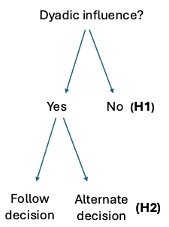annhuang
Mutually exclusive, collectively exhaustive
May 23, 2025Latly I’ve been watching some common case interview questions for those big tier-1 consulting firms. There’s a term I picked up, which is “mutually exclusive, collectively exhaustive”, or MECE. This describes a framewok that is commonly used for solving ambiguous questions, such as: should you open a cafe in downtown Los Angeles? How many people in the Netherlands apply to data scientist jobs each year?
Because these questions are quite vague, a structured approach or framework is needed develop a concrete answer. A structured framework basically guides the probelm-solving process by breaking the question down into definable bits and pieces. For instance, people usually start with an anchor number like population of the city, segment that population group by sex, age, etc, then work their way down the defined items using a combination of logic and quantitative thinking to come up with a concrete solution to the ambiguous question.
There are many frameworks that guide the steps of quantiative problem-solving, but some are better than the others. One of the characteristics of a good framework is MECE. For example, the profitability framework demonstrates MECE, because each of the item is specific, and does not overlap with each other; moreover, the items are exhaustive, indicating that the person has thought of all the possibilties that pertain to the probelm.
So, whenever you are confronted with an ambiguous problem, think MECE.
While learning about these case interviews, I realized I have also thought MECE before. I used it in a scientifc context.
When I conducted the research study investigating the choice history biases in dyadic (or social) perceptual decision-making, I applied a similar framework to problem-solving that was MECE.
Essentailly, I wanted to know whether observing others, or being observed, influences one’s perceptual choices. I began with a deep-dive into the academic literature to gain subject expertise and identify knowledge gap. I then defined the research question and formulated hypotheses in both natural language texts and quantitative parameters.
The latter part was important as it showcased how MECE was applied.
Anyway the research objective was to determine whether perceptual decision-making is more of an individualistic (independent of the co-actor’s action) or collective (contingent on the co-actor’s action) process despite the co-actor’s actions being irrelevant to the present decision.
The competing hypotheses we came up were: the participants equally weigh their own and their partner’s decision history, or the participants do not weigh equally their own and their partner’s decision history.
Two statements. They seem simple, right?
Well, not that easy to wrap my head around it, at least for me in the first couple of rounds. I actually went through multiple iterations to get it super clear and quantitatively accurate. Here the principle was the same - to make sure the things you’re using to test or solve the probelm are mutually exclusive also collectively exhaustive without any redundency.
One of the previous iterations were: the participants equally weigh their own and their partner’s decision history, or the participants alternate from their partner’s decisions. Sounds simliar but there’s a slight difference.
The first hypothesis is the null hypothesis, which states that the participants equally weigh their own and their partner’s decision history. This suggests that the choice history bias effect is not limited to a specific actor in the dyad but relates to the combined sequence of decisions by the dyad. The second hypothesis states that the participants alternate from their partner’s decisions. This assumes the choice history effect is influenced by the specific actor; specifically, the participants do not ignore their partner’s decisions yet treat them differently from their own.
Here is a diagram describing how the formulated hypotheses match with the research objective. The first hypothesis statement (H1) assumes the choice history bias effect relates to the combined sequence of the decisions. The second hypothesis statement (H2) assumes choice history bias is influenced by the specific actor, specifically that the participants alternate from their partner’s decisions.

However, this apparently confused the reviewer. The reviewer’s exact question was: “H1 was mentioned as the “null hypothesis” (which would usually be called H0), so what is the alternative hypothesis? If you perform a statistical test, you test a hypothesis (usually called “HA” or “H1”, not the same as what the authors call “H1”) against a null hypothesis H0. Usually HA = effect, H0 = no effect. This is made more complicated by the diagram which seems to show something different than this….”
There was a long back-and-forth regarding the hypotheses statements. One of the principle used was whether the statements were mutually exclusive?
Then the part about “collectively exhaustive” i.e., does your framework covers the “entire universe of possibilities” to solving the problem?
This part relates to the quantitative approach I used, i.e., the stewpise regression approach. For the modeling appraoch, the optimal solution was to start with a statistical model that accounts the “entire universe of possibilities” in predicting the acting person’s choice response. The possibilities included things like the previous response, the response two trials ago, who responded it, the correctness of the response, etc. Then the most sophisticated model that covers all the possibilites is tested against the hypotheses and simplified step-by-step until a we arrive at a conclusion.